Estimated Reading Time: 9 minutes
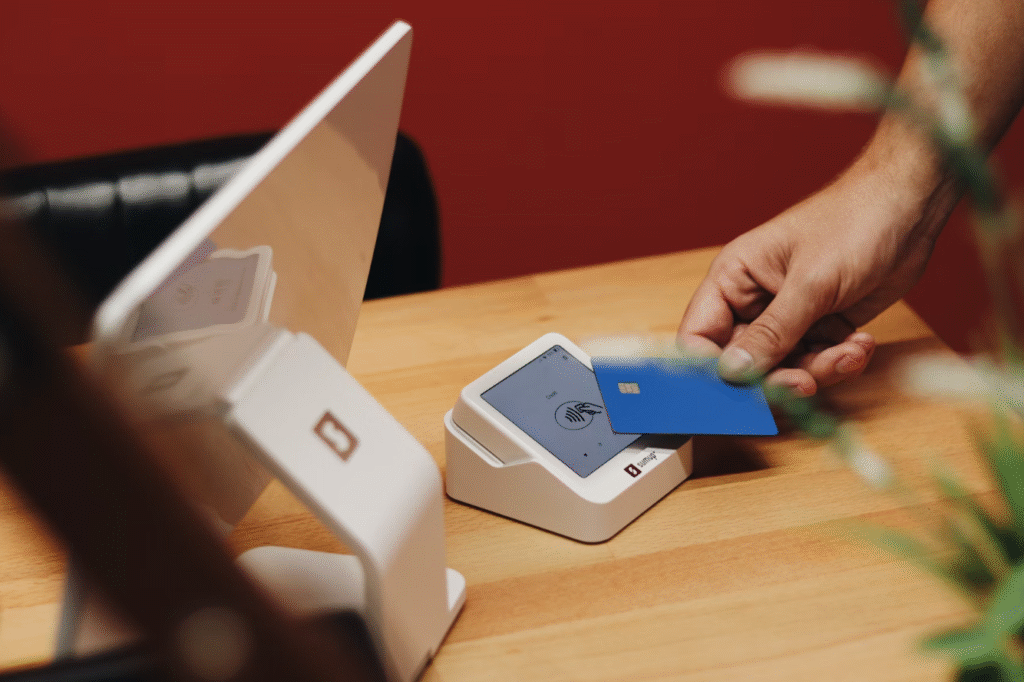
Today’s shoppers are spoiled and it’s your fault (well, partly).
With same-day shipping, personalized ads, and instant discounts just a tap away, their expectations are sky-high. So when they join your loyalty program, they’re not looking for a dusty punch card or a “Buy 9, get the 10th free” deal. They want something that feels fresh and worth sticking around for.
In 2025, retail loyalty programs play a key role in customer retention, personalization, and brand engagement.
Whether you run an eCommerce store or a brick and mortar boutique, having a digital loyalty program that works across both online and offline channels helps increase repeat purchases and build stronger relationships.
Think of it this way: if Netflix only offered one show, would you keep paying for it? Probably not. The same goes for loyalty programs—if your rewards are flat, customers will tune out immediately.
On the bright side, loyalty programs can still be a retailer’s secret weapon.
Let’s break down the five must-have features that separate loyalty programs customers love, and the ones they forget five minutes after signing up.
What Separates a Good Loyalty Program from a Great One
A good retail loyalty program gets customers in the door.
A great one makes them feel like they’d be missing out if they ever left.
The difference usually comes down to design: good programs hand out points, while great ones weave loyalty into the entire shopping experience.
Why Customers Expect More Today
Loyalty used to be simple: give people a stamp card, and they’ll eventually come back for the freebie.
But, times have changed.
Today’s customers expect the kind of experience they already get from Netflix, Spotify, or even Amazon. Convenience, personalization, and instant gratification.
No more clunky retail loyalty programs. Shoppers are spoiled for choice now and switching brands is easier than ever before. A great loyalty program for retail is one that keeps pace with these expectations, offering experiences and recognition.
The Danger of “Copy-Paste” Loyalty Schemes
Many retailers fall into this trap. Pay attention.
Retailers copy whatever loyalty program their competitor is doing. On paper, it feels safe—but in practice, it makes your brand forgettable.
If three stores on the same street all offer “collect points, redeem later”, why would anyone feel attached to yours?
Customers join retail loyalty programs because they want value they can’t get anywhere else. That could mean creative tiers, experiential rewards, or simply a smoother mobile-first system.
This is why platforms like SimpleLoyalty matter. It lets you design something unique to your brand instead of pushing you into the same tiered templates everyone else is using.
5 Must-Have Features of Retail Loyalty Programs
1. Omnichannel Integration Across In-Store and Online
Your customers don’t think in “channels”. In fact, they don’t care whether they’re shopping in-store, online, or even through Instagram. They just want their rewards to work everywhere.
Omnichannel integration ensures your loyalty program feels seamless, no matter where the transaction happens. This goes beyond just syncing points. It’s about making the customer feel like they’re interacting with one brand, not two disconnected systems.
That means:
- Points should be credited instantly both online and offline
If a customer buys in-store, they should see their balance update in-app within minutes.
- Points should also be redeemable across channels
A discount earned online should work just as easily at the checkout counter in-store, and vice versa.
- Promotions and voucher codes should apply everywhere (unless clearly specified otherwise)
For instance, if you’re running an exclusive “in-store only” weekend deal, that needs to be communicated upfront. Otherwise, customers expect codes from email or social media to work in all touchpoints.
Example:
Nike Membership nails this approach. Whether a customer shops online, in-store, or through the app, they’re rewarded consistently. Members even unlock exclusive workout content and product drops, which blurs the line between shopping and lifestyle.
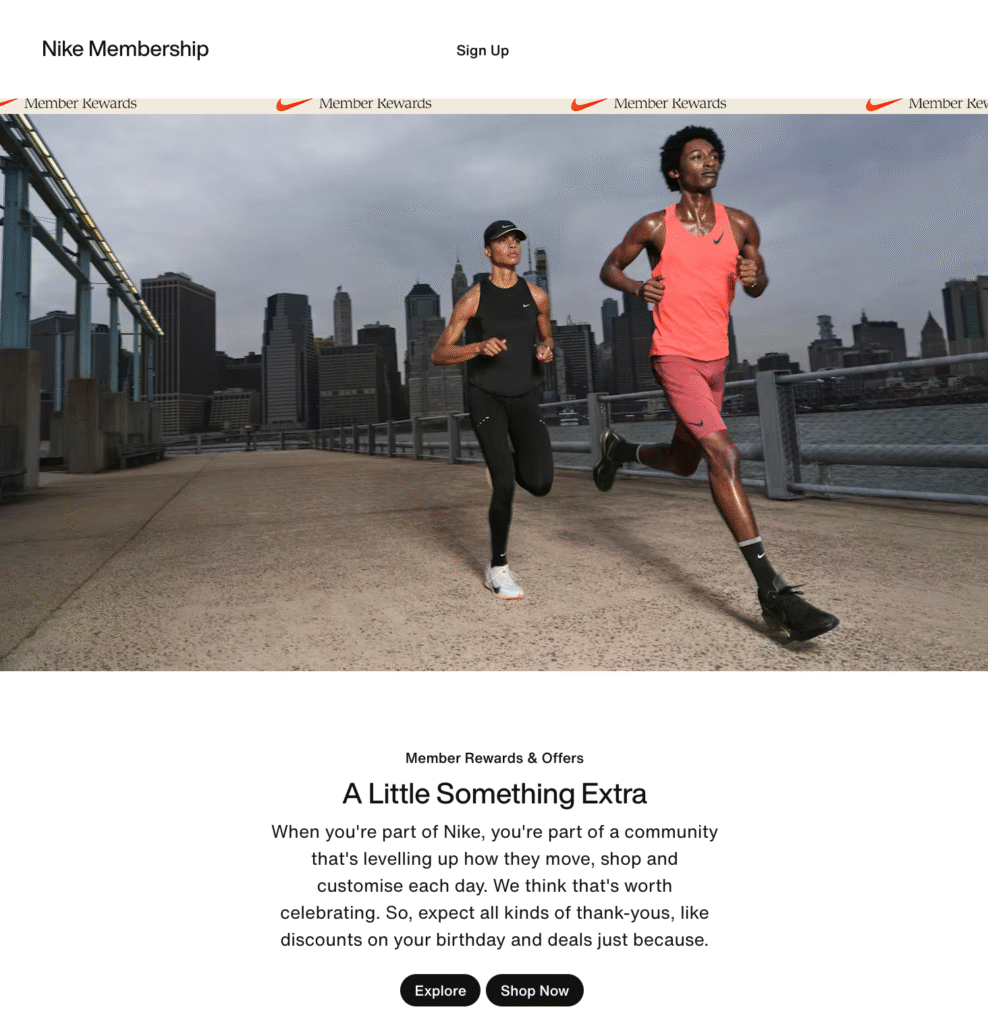
For retailers, omnichannel loyalty programs also mean more data touchpoints, giving you a fuller picture of customer behavior across platforms.
2. Flexible and Tiered Reward Structures
Flat rewards are the loyalty equivalent of watching paint dry.
Functional, but not exciting. At all.
Imagine moving from “Basic Member” to “VIP Insider”. Each tier unlocks new perks, from early access to products, to premium discounts. The psychology is super simple: once customers see a higher tier, they want to get there—and they’ll spend more to achieve it.
Example:
Sephora’s Beauty Insider has mastered this. Members who spend more unlock better perks like deluxe samples, birthday gifts, and exclusive invites. Customers talk about reaching “Rouge status” like it’s a milestone in life.
That’s loyalty done right.
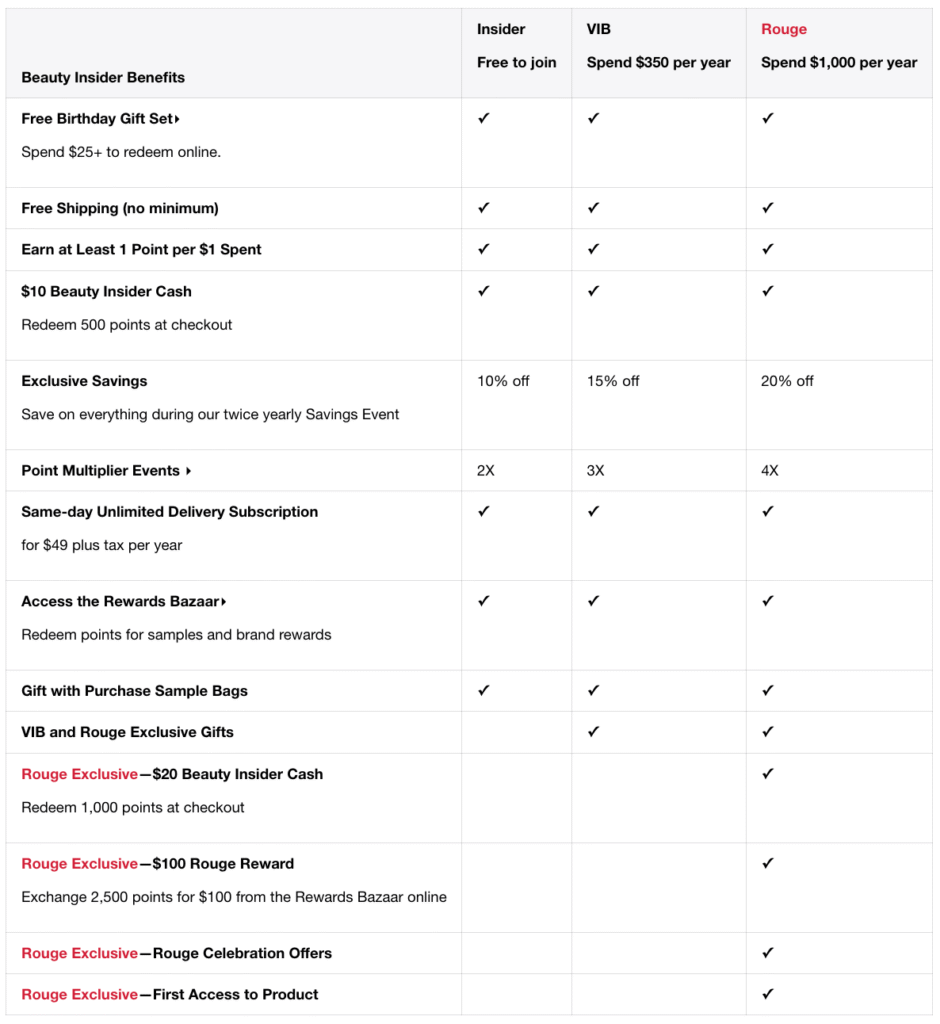
Retailers who want to stand out should also consider non-monetary tiers, like access to communities, content, or experiences. Things that money can’t buy, but loyalty can.
3. Personalized Recommendations and Offers
At its core, loyalty isn’t just about collecting points — it’s about communication. Sending regular offers and rewards to your customers (whether personalized or not) keeps your brand top of mind.
Personalized offers, however, make customers feel like VIPs.
Would you rather get a random coupon for socks you don’t need, or 20% off the exact skincare brand you’ve been eyeing?
Personalization in retail loyalty programs can look like:
- Tailored discounts based on purchase history
- Curated product suggestions
- Reminders about restocks or seasonal favorites
- Special perks tied to birthdays
Example:
Starbucks Rewards is legendary. The app “knows” your go-to order and sends you deals for the exact items you love. This keeps customers coming back (and talking about it).
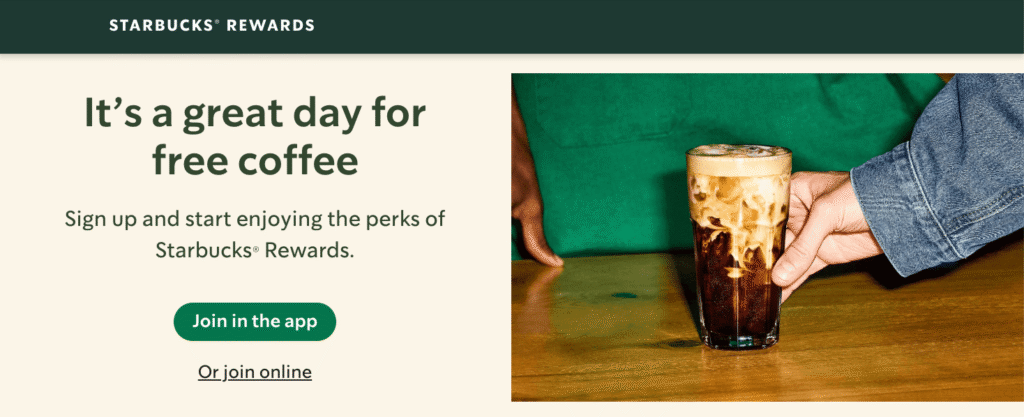
With the right platform like SimpleLoyalty, personalization becomes scalable. All you need is smart data collection and automation.
4. Mobile-Friendly User Experience
Nobody uses physical punch cards anymore. If your retail loyalty program isn’t mobile-friendly, it’s already halfway to the graveyard of forgotten ideas.
A mobile-first retail loyalty program makes it effortless to:
- Sign up in seconds
- Check points and perks on the go
- Redeem rewards with a tap
- Engage with your brand through push notifications
Example:
H&M’s app blends loyalty into the shopping experience seamlessly. Not only can customers track points, but they also get personalized style content, receipts stored in-app, and barcode scanning at checkout.
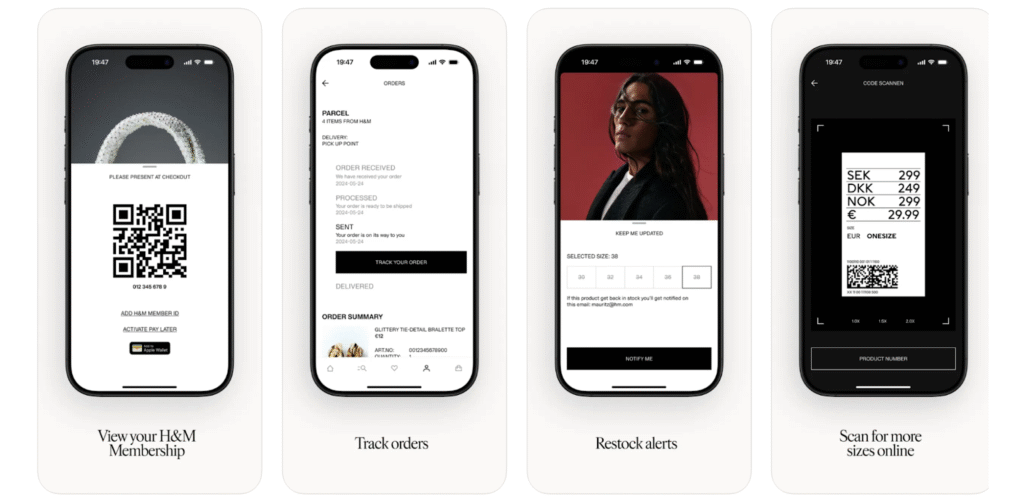
It’s not just a loyalty app, but a part of their entire retail experience. The easier it is for customers to engage, the more likely they are to stick around.
5. Real-Time Analytics
Here’s where the magic happens—for the retailer, at least. Real-time analytics are the difference between guessing and knowing what’s working in your loyalty program.
Analytics let you see:
- Which rewards get redeemed most often
- Which customers are at risk of churning
- Which products drive the most repeat visits
- How spending habits shift across different tiers
Platforms like SimpleLoyalty make this easier by turning raw data into actionable insights.
[H2] Examples of Retail Brands Using These Features
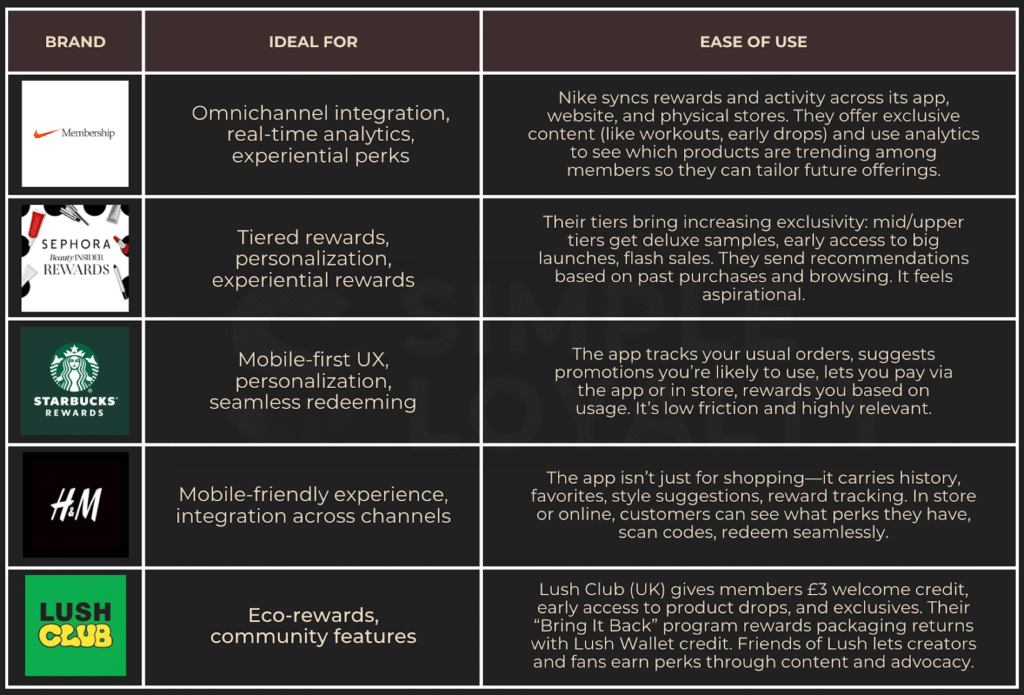
- Nike Membership: Omnichannel shopping tied with lifestyle perks.
- Sephora Beauty Insider: Tiered rewards that feel aspirational.
- Starbucks Rewards: Personalization that feels like a barista who knows your order.
- H&M App: Mobile-first loyalty embedded in daily shopping.
- Lush Club UK: A unique model where members get £3 welcome credit, exclusive early access to new product drops, and perks through Lush Wallet.
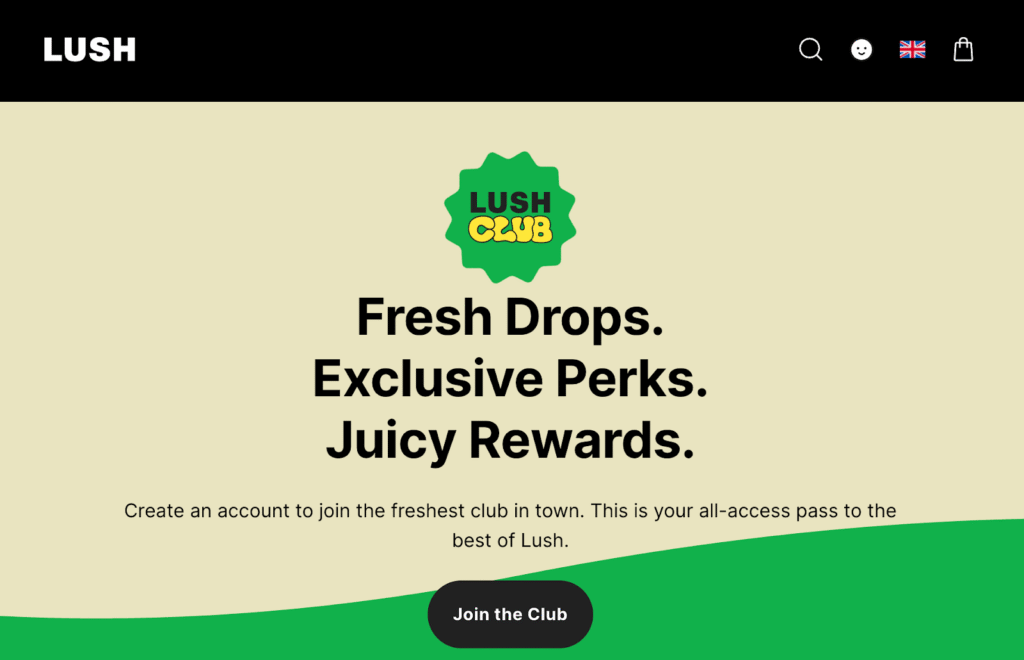
Notice how each retail loyalty program looks different?
That’s the point.
A loyalty program should reflect your brand, not copy your competitor’s.
How Retailers Can Add These Features to Loyalty Programs
Here are practical steps you can use to build or refine your retail loyalty program that actually leverages those features. Think of this as your “playbook”.
- Map the full customer journey
- Identify all touchpoints where customers interact with your brand: website, mobile app, physical store, social media, etc.
- Use surveys, interviews, or customer feedback to find pain points (e.g., “I couldn’t use points earned online in store”).
- For each touchpoint, define how rewards or status should behave. For instance, if someone orders online and then picks up in-store, make sure points and perks show up in both places immediately.
- Choose the right platform
- Look for platforms that support omnichannel reward or point tracking (online + offline) and can sync in near real time. Here’s a guide on implementing an omnichannel loyalty program and the platform features you’ll need.
- Ensure the platform allows tiered structuring. Tiers should be flexible enough for monetary tiers and non-monetary perks.
- Prioritize mobile UX: app, mobile site, digital wallet features. Test them on different devices.
- Design rewards that feel unique and valuable
- Mix perks: discounts, freebies, exclusive access, early product drops, experiential rewards (events, workshops, content).
- Encourage non-monetary rewards: recognition, community features, ethical/eco perks (like Lush’s packaging returns).
- Make tiers that customers aspire to. But make sure the jump between tiers is possible (not ridiculously high).
- Use data & analytics
- Track which rewards are redeemed, which offers work, churn rates (when customers stop engaging).
- Use segmentation: new customers, big spenders, dormant customers, etc. Craft offers specific to each segment.
- A/B test aspects: reward thresholds, types of perks, how often you communicate.
- Train your team & promote it everywhere
- Your store staff should know how the loyalty program works so they can explain it to customers, help them sign up, and resolve issues.
- Promote everywhere: in-store signage, receipts, email, social media, and packaging. Don’t assume customers will figure it out themselves.
- Use onboarding: when someone signs up, send them a welcome message with a quick tutorial of the perks, how to use rewards, etc.
- Monitor feedback & adjust
- Collect feedback (via surveys, reviews, customer support queries). What’s confusing? What feels unrewarding?
- Keep an eye on metrics: redemption rate, active membership percentage, frequency of purchase, average spend per loyalty member.
- Be willing to tweak rewards, tiers, communication cadence. Loyalty isn’t “set it and forget it”.
Conclusion
Retail loyalty programs aren’t side projects anymore. They’re the difference between being a brand customers love and a brand they forget.
The retailers thriving in 2025 are the ones who stop treating loyalty like an afterthought and start building binge-worthy experiences.
So, the question isn’t whether you should have a loyalty program. Ask yourself this instead:
“Is my loyalty program so good that customers would recommend it to a friend, the same way they rave about their favorite Netflix show?”
If the answer’s “not yet”, don’t worry.
Let SimpleLoyalty make this process smooth and effective for your brand.

